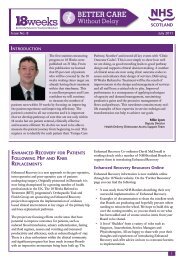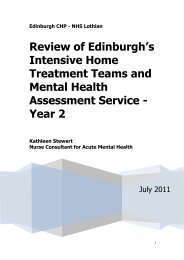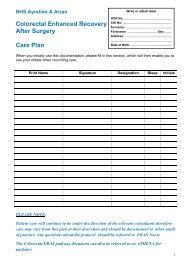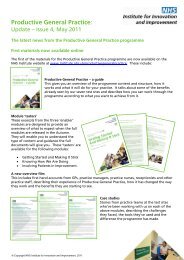A Step-by-Step Guide to Developing Protocols... - Quality ...
A Step-by-Step Guide to Developing Protocols... - Quality ...
A Step-by-Step Guide to Developing Protocols... - Quality ...
Create successful ePaper yourself
Turn your PDF publications into a flip-book with our unique Google optimized e-Paper software.
Modernisation Agency<br />
National Institute for<br />
Clinical Excellence<br />
A <strong>Step</strong>-<strong>by</strong>-<strong>Step</strong> <strong>Guide</strong> <strong>to</strong> <strong>Developing</strong> Pro<strong>to</strong>cols...
INTRODUCTION<br />
A number of NHS organisations are already required <strong>to</strong> produce<br />
pro<strong>to</strong>cols as part of the implementation of NSFs, for example:<br />
• all secondary care providers should have had pro<strong>to</strong>cols for the<br />
management of coronary heart disease in place since April 2001<br />
• ambulance services should have had pro<strong>to</strong>cols for the<br />
management of acute myocardial infarction since April 2001<br />
• primary care should have had pro<strong>to</strong>cols for the secondary<br />
prevention of coronary heart disease, heart failure and<br />
rehabilitation since April 2002.<br />
However, a pro<strong>to</strong>col can improve care in almost any setting.<br />
It is a valuable <strong>to</strong>ol for people who are delivering care across a<br />
department, as part of a clinical network or on a multi-agency<br />
basis, and <strong>to</strong> those working in a small, discrete team.<br />
This information has been prepared <strong>by</strong> the Modernisation Agency and the National<br />
Institute for Clinical Excellence <strong>to</strong> support the development of pro<strong>to</strong>col-based care within<br />
the NHS in England. It may also be of interest <strong>to</strong> those working in the NHS in Wales.<br />
The documents do not represent formal NICE guidance <strong>to</strong> the NHS.<br />
1
Key steps <strong>to</strong> developing pro<strong>to</strong>cols<br />
Pro<strong>to</strong>cols can be developed in a variety of<br />
different ways. The purpose of this guide is <strong>to</strong><br />
offer one option for a step-<strong>by</strong>-step approach<br />
<strong>to</strong>wards development and implementation.<br />
One<br />
Two<br />
Three<br />
Four<br />
SELECT AND<br />
PRIORITISE A<br />
TOPIC<br />
SET UP<br />
A TEAM<br />
INVOLVE<br />
PATIENTS<br />
& USERS<br />
AGREE<br />
OBJECTIVES<br />
Twelve<br />
Five<br />
REVIEW THE<br />
PROTOCOL<br />
BUILD<br />
AWARENESS &<br />
COMMITMENT<br />
Eleven<br />
Six<br />
MONITOR<br />
VARIATION<br />
GATHER<br />
INFORMATION<br />
Ten<br />
Nine<br />
Eight<br />
Seven<br />
IMPLEMENT<br />
THE PROTOCOL<br />
PILOT THE<br />
PROTOCOL<br />
PRODUCE THE<br />
PROTOCOL<br />
BASELINE<br />
ASSESSMENT<br />
2
Key steps <strong>to</strong> developing pro<strong>to</strong>cols<br />
<strong>Step</strong> One<br />
Select and Prioritise a Topic<br />
1. The <strong>to</strong>pic <strong>to</strong> be covered <strong>by</strong> the pro<strong>to</strong>col<br />
should be selected through two<br />
main routes:<br />
• the publication of national standards<br />
• the identification of local service<br />
improvement priorities.<br />
It is also important <strong>to</strong> consider the<br />
context in which the pro<strong>to</strong>col will be<br />
used, because this will determine the<br />
basis for its development. Examples are<br />
given below.<br />
Examples of types of pro<strong>to</strong>cols<br />
Type of pro<strong>to</strong>col<br />
disease-based<br />
problem-based<br />
treatment-based<br />
client-group-based<br />
National standards<br />
2. These contain detailed guidance – based<br />
on research evidence – on the processes<br />
of care that need <strong>to</strong> be in place at a<br />
local level <strong>to</strong> deliver and achieve best<br />
practice. They will provide a framework<br />
for local groups <strong>to</strong> develop pro<strong>to</strong>colbased<br />
care; an example is the NICE<br />
guideline on pressure ulcer risk<br />
assessment and prevention.<br />
Identification of local service<br />
improvement priorities<br />
3. NICE guidance, National Service<br />
Frameworks (NSFs) and other national<br />
standards do not cover all areas of<br />
patient care. A number of<br />
organisations have used the<br />
development of pro<strong>to</strong>col-based care <strong>to</strong><br />
review and improve complex local<br />
systems, and <strong>to</strong> streamline the delivery<br />
of care – for example in hospital<br />
accident and emergency departments,<br />
or in treating stroke patients –<br />
according <strong>to</strong> local priorities.<br />
Example<br />
diabetes, asthma, stroke, cancer<br />
chest pain, disturbed behaviour, anxiety<br />
hip replacement, cataract removal<br />
people with learning disabilities,<br />
neonates, older people<br />
4. The following considerations may be<br />
useful in selecting an area <strong>to</strong> work on:<br />
• priority should be given <strong>to</strong><br />
development of pro<strong>to</strong>cols <strong>to</strong> support<br />
the implementation of NICE guidance,<br />
NSFs, Department of Health (DH)<br />
strategies and modernisation initiatives<br />
• also look for <strong>to</strong>pics with one or more<br />
of the following characteristics:<br />
– the disease follows a relatively<br />
predictable course and the process<br />
of care is relatively standardised<br />
– large numbers of people require<br />
care for the condition or disease<br />
– the procedure is very high cost<br />
– the procedure is low volume<br />
– the area represents a high risk <strong>to</strong><br />
the organisation<br />
– the area is highlighted for action<br />
<strong>by</strong> the Commission for Health<br />
Improvement, the Audit Commission<br />
or Mental Health Act Commissioners<br />
– clinical governance considerations<br />
indicate that action is necessary<br />
– information from patient complaints<br />
suggests that action is necessary<br />
– new evidence has become available<br />
– patients and service users express<br />
interest in a particular issue or area.<br />
3
<strong>Step</strong> Two<br />
Set up a Team<br />
5. Experience has shown that the<br />
involvement of the staff responsible for<br />
the hands-on delivery of care is central<br />
<strong>to</strong> the successful development and use<br />
of pro<strong>to</strong>cols. The first step in the<br />
process, therefore, is <strong>to</strong> set up a multidisciplinary<br />
team, made up of all<br />
clinical and non-clinical staff involved in<br />
care delivery.<br />
6. In selecting members for the team, a<br />
number of roles will need <strong>to</strong> be<br />
agreed, and some people may fill more<br />
than one role. Although there are no<br />
hard and fast rules about how many<br />
people <strong>to</strong> have in a team, experience<br />
suggests that large groups can become<br />
unwieldy, and that the optimal number<br />
of people <strong>to</strong> have in a team is between<br />
6 and 10. Those setting up the team<br />
should consider including:<br />
• a clinical leader <strong>to</strong>:<br />
– facilitate discussions<br />
– ensure integration with clinical audit<br />
– link work with teaching and<br />
change management<br />
– maintain momentum for the project<br />
– help group members <strong>to</strong> challenge<br />
current practice constructively<br />
• a clinical champion<br />
• patient and user representation<br />
(see <strong>Step</strong> 3)<br />
• an information specialist or analyst <strong>to</strong><br />
advise on the organisation’s systems for<br />
information management, the analysis<br />
of local information, and the use of<br />
information technology<br />
• a Caldicott guardian (or equivalent)<br />
<strong>to</strong> advise on information sharing <strong>to</strong><br />
support the delivery of care<br />
• clinical and non-clinical staff<br />
representatives who cover the wide<br />
range of groups involved in the<br />
delivery of care<br />
• administrative and clerical support <strong>to</strong>:<br />
– arrange meetings<br />
– minute discussions and decisions<br />
– prepare documentation<br />
• a pro<strong>to</strong>col co-ordina<strong>to</strong>r <strong>to</strong>:<br />
– link pro<strong>to</strong>col development<br />
projects across the organisation<br />
– provide expert advice on the<br />
development of pro<strong>to</strong>cols<br />
– support the clinical leader<br />
– support implementation<br />
• information support from NHS library<br />
services, such as document search<br />
and delivery.<br />
7. The team should have access <strong>to</strong> clearly<br />
identified resources, for example, <strong>to</strong><br />
make notes of meetings, <strong>to</strong> record<br />
decisions taken and <strong>to</strong> prepare<br />
documentation. In the early stages at<br />
least, the team may benefit if its work<br />
is facilitated <strong>by</strong> a co-ordina<strong>to</strong>r who has<br />
credibility with all its members. Most<br />
importantly, the team should reflect a<br />
broad range of opinions and ideas in<br />
order <strong>to</strong> identify, and then implement,<br />
the most effective standards of care.<br />
8. The team should also look at how it<br />
will link in<strong>to</strong> local priorities and its<br />
organisation’s processes <strong>to</strong> secure and<br />
provide services relevant <strong>to</strong> its<br />
population.<br />
9. Once the team is established, it will<br />
need <strong>to</strong> agree the role of the group<br />
and its terms of reference. It may be<br />
helpful for the group <strong>to</strong> manage its<br />
progress <strong>by</strong> agreeing:<br />
• a communications plan (see Annex 2)<br />
• the timescale for the project<br />
• a project plan and meeting schedule<br />
(see Annex 3)<br />
• an implementation plan with links <strong>to</strong><br />
local commissioning and contracting<br />
processes (see <strong>Step</strong> 10)<br />
• goals and objectives for the pro<strong>to</strong>col<br />
(see <strong>Step</strong> 4).<br />
10. Although there is no set view on the<br />
time that it should take <strong>to</strong> develop a<br />
pro<strong>to</strong>col, the experience of people who<br />
have successfully developed them<br />
suggests that it is reasonable <strong>to</strong> expect<br />
the process <strong>to</strong> take between three and<br />
six months from start <strong>to</strong> implementation.<br />
4
Key steps <strong>to</strong> developing pro<strong>to</strong>cols<br />
<strong>Step</strong> Three<br />
Involve Patients and Users<br />
11. Involving patients is essential in<br />
planning service improvements. Indeed,<br />
one of the key principles underpinning<br />
the NHS Plan and the Government’s<br />
overall strategy for modernising the<br />
health service is that the views of<br />
patients and their carers, relatives and<br />
representatives should inform the way<br />
local NHS services are designed and<br />
delivered. The involvement of patients<br />
and service users is, therefore, an<br />
essential part of the process of<br />
developing a pro<strong>to</strong>col, and it is<br />
extremely important that they should<br />
be actively involved in the decisionmaking<br />
process. It may be useful <strong>to</strong><br />
produce a summary of the pro<strong>to</strong>col for<br />
patients and service users.<br />
12. Various mechanisms can be used <strong>to</strong><br />
involve patients and users in the<br />
decisions on current service<br />
development. For example, information<br />
could come from:<br />
• patient representatives on the pro<strong>to</strong>col<br />
development team<br />
• consumer or interest group<br />
representatives on the pro<strong>to</strong>col<br />
development team<br />
• patients’ forums – Patient Advice and<br />
Liaison Services (PALS) need <strong>to</strong> be<br />
included because their reports will<br />
provide views<br />
• patient associations<br />
• complaints<br />
• analysis of patient and user feedback –<br />
both positive and negative.<br />
<strong>Step</strong> Four<br />
Agree Objectives<br />
13. It is important that any pro<strong>to</strong>col should<br />
be associated with clear objectives that<br />
are specific, measurable and have targets<br />
for achievement (see table right). In<br />
setting objectives, the development<br />
team should identify targets that are<br />
achievable, but sufficiently challenging <strong>to</strong><br />
lead <strong>to</strong> real service improvements. NSFs<br />
and guidance issued <strong>by</strong> NICE contain<br />
audit criteria that can be used <strong>to</strong> inform<br />
local objectives.<br />
14. It is important <strong>to</strong> ask staff what<br />
particular problems or barriers <strong>to</strong><br />
effective care delivery they experience,<br />
and agree which of these can be<br />
translated in<strong>to</strong> objectives for the<br />
pro<strong>to</strong>col. The patient perspective will<br />
also be useful here.<br />
5
Examples of objective setting<br />
Objective Measurement Target<br />
Elimination of unexpected overnight Number of overnight stays, 50% reduction in one year<br />
stays in acute unit after day surgery with reason<br />
Reduction of inappropriately % of antibiotics inappropriately reduction <strong>by</strong> 50% in each of the next 3 years<br />
prescribed antibiotics<br />
prescribed/per month<br />
Reduction in the number % of medication errors/per month Increase reporting but decrease severity<br />
of medication errors<br />
Increased patient satisfaction with care Documented patient agreement <strong>to</strong> care 100% of patients<br />
through the provision of information (including information sharing)<br />
Elimination of long waits (> 4 hours) Number of patients waiting over 4 hours Nil<br />
in A&E departments<br />
in A&E departments<br />
Introduce nurse-directed requests % of requests initiated <strong>by</strong> nurses Could be variable, depending on the type<br />
for radiology in A&E departments<br />
of request. For example, 100% requests<br />
from a minor injuries patient stream or<br />
suspected fracture neck of femur; 50%<br />
increase in nurse-requested chest x-ray<br />
Increase the number of patients % of patients attending each service Differentiate for different conditions.<br />
transported after 999 calls <strong>to</strong> minor (separated <strong>by</strong> condition/presentation) For example, 15% of the <strong>to</strong>tal with<br />
injury units, walk-in centres and<br />
an increasing target year <strong>by</strong> year<br />
primary care centres as alternatives<br />
<strong>to</strong> A&E departments<br />
Reduction in the number of patients Present measures of delayed Reduce <strong>to</strong>
Key steps <strong>to</strong> developing pro<strong>to</strong>cols<br />
<strong>Step</strong> Five<br />
Build Awareness and Commitment<br />
15. The implementation of pro<strong>to</strong>col-based<br />
care can only be successful if there is<br />
visible, high-level support and<br />
awareness within an organisation.<br />
Strong clinical support is essential, not<br />
only from medical and nursing<br />
direc<strong>to</strong>rs, but also from the wide range<br />
of professions involved in the care of<br />
patients. Patients’ forums will also<br />
need <strong>to</strong> understand and be engaged<br />
with the process.<br />
16. The commitment of the chief<br />
executive, senior managers, medical<br />
and nursing direc<strong>to</strong>rs, and nonexecutive<br />
direc<strong>to</strong>rs will ensure that the<br />
programmes implementing pro<strong>to</strong>colbased<br />
care are supported, and become<br />
fully integrated in<strong>to</strong> the organisation’s<br />
way of working. In particular, ensure<br />
that the finance department is<br />
consulted so that any financial<br />
implications are considered, and that<br />
strong links are made at an early stage<br />
with clinical governance, Caldicott<br />
and information governance,<br />
workforce development, and<br />
corporate governance.<br />
17. Consideration should be given at an<br />
early stage as <strong>to</strong> how current resources<br />
can be used <strong>to</strong> support the<br />
development of pro<strong>to</strong>col-based care.<br />
Some organisations have found it<br />
helpful <strong>to</strong> identify a pro<strong>to</strong>col coordina<strong>to</strong>r<br />
who can provide expertise <strong>to</strong><br />
support the development of pro<strong>to</strong>cols<br />
as well as maximising learning<br />
throughout the organisation.<br />
Suggestions for raising awareness and<br />
gaining commitment<br />
18. The benefits of developing pro<strong>to</strong>colbased<br />
care could be maximised <strong>by</strong>:<br />
• actively engaging with patients, users<br />
and carers<br />
• using NICE guidance, NSFs and DH<br />
guidance requirements as the basis for<br />
pro<strong>to</strong>col development<br />
• identifying a range of activities already<br />
taking place in the organisation as a<br />
basis for pro<strong>to</strong>col development<br />
• making presentations or giving short<br />
seminars <strong>to</strong> key groups of staff,<br />
patients’ forum members and board<br />
members <strong>to</strong> raise awareness of the<br />
benefits of pro<strong>to</strong>col-based care.<br />
7
<strong>Step</strong> Six<br />
Gather Information<br />
19. Information should be sought on:<br />
• national standards<br />
• published evidence of good practice<br />
• other organisations’ experience and<br />
pro<strong>to</strong>cols<br />
• the views of patients and service<br />
users, through local information and<br />
the programme of national surveys<br />
of patient experience, and in relation<br />
<strong>to</strong> NSFs.<br />
20. The development team should clarify<br />
and build on the arrangements within<br />
their own organisation for receiving<br />
national standards such as NICE<br />
guidance and NSF publications, and<br />
ensure that these are distributed <strong>to</strong> the<br />
appropriate areas and their<br />
implementation moni<strong>to</strong>red.<br />
21. The development team will also find it<br />
useful <strong>to</strong> have a clear understanding,<br />
perhaps from their organisation’s<br />
business plan, of their service objectives<br />
and of any plans <strong>to</strong> change or develop<br />
the organisation’s strategic direction.<br />
This will help them decide which areas<br />
should be priorities for action.<br />
22. The booklet Where <strong>to</strong> Get More Help<br />
and Information describes a number of<br />
sources of information and how these<br />
can be accessed. The National<br />
electronic Library for Health contains<br />
examples of pro<strong>to</strong>cols that have been<br />
used elsewhere in the service. While<br />
these may need <strong>to</strong> be adapted or<br />
enhanced <strong>to</strong> satisfy emerging<br />
requirements, they can be useful <strong>to</strong> the<br />
development team, since they can give<br />
ideas on the content and format of the<br />
pro<strong>to</strong>col. NHS libraries can also offer<br />
access <strong>to</strong> a wide range of relevant<br />
knowledge sources, and early contact<br />
with library staff will enable them <strong>to</strong><br />
best assist the team. Some areas have<br />
designated clinical librarians working<br />
within clinical teams.<br />
23. Pro<strong>to</strong>cols should be built on an<br />
evidence base of what is required <strong>to</strong><br />
achieve good care. If there are limited<br />
sources of information about the area<br />
of care under consideration, then the<br />
team will need <strong>to</strong> reach a consensus<br />
on good practice. It is not always easy<br />
<strong>to</strong> reach a well-founded judgement<br />
when there is a lack of reliable<br />
evidence. Therefore, it may be wise –<br />
at least in early work – <strong>to</strong> develop<br />
pro<strong>to</strong>cols for diseases or conditions<br />
where there is a national standard of<br />
good practice.<br />
24. Sources of data for establishing a<br />
baseline of current performance can<br />
also be identified at this stage.<br />
Remember <strong>to</strong> seek advice from<br />
Caldicott guardians if handling<br />
confidential patient information. Links<br />
should also be made in<strong>to</strong> the local<br />
audit team and their procedures. The<br />
published national indica<strong>to</strong>rs of clinical<br />
performance may also be a fruitful<br />
source for identifying areas for<br />
development. Likewise, the annual<br />
consultation exercise on what should<br />
be included in national performance<br />
indica<strong>to</strong>rs, and the responses <strong>to</strong><br />
consultation, may help identify areas<br />
for future coverage <strong>by</strong> pro<strong>to</strong>cols (see<br />
also paragraph 47).<br />
8
Key steps <strong>to</strong> developing pro<strong>to</strong>cols<br />
<strong>Step</strong> Seven<br />
Baseline Assessment<br />
25. The next step is <strong>to</strong> determine the<br />
baseline of current performance.<br />
This can help the team <strong>to</strong> analyse<br />
local services and <strong>to</strong> identify where<br />
improvements might be made. Sources<br />
of data for evaluating the baseline<br />
will have been collected during the<br />
information-gathering stage, and<br />
analysis of the data should begin <strong>to</strong><br />
highlight where there are shortcomings<br />
in the current service and where the<br />
most valuable improvements can<br />
be made.<br />
26. The development team will need <strong>to</strong><br />
map the care provided for the chosen<br />
group of patients. For some conditions<br />
this can be complex. The Service<br />
Improvement Direc<strong>to</strong>rate, part of the<br />
Modernisation Agency, has worked<br />
with more than 500 local clinical teams<br />
and their experience has shown the<br />
clear benefits of the creation of a<br />
simple, high-level process map giving<br />
the main elements that are currently<br />
used <strong>to</strong> deliver the care objective. An<br />
example of a process map is given in<br />
Annex 4. To establish the areas for<br />
improvement, a process map will need<br />
<strong>to</strong> go <strong>to</strong> a deeper level, revealing a<br />
greater number of process steps.<br />
27. The high-level map will form the basis<br />
of a more detailed mapping process.<br />
This process should describe how care<br />
is delivered in practice, and should<br />
include a timeframe of interventions<br />
and the points at which decisions are<br />
normally taken. An analysis of case<br />
notes may also offer a good insight<br />
in<strong>to</strong> how care is delivered under the<br />
current arrangements. It may also be<br />
helpful <strong>to</strong> use one-<strong>to</strong>-one interviews<br />
with key stakeholders, and group<br />
sessions with patients and staff, <strong>to</strong> get<br />
a wide perspective on service provision.<br />
28. An important objective will be <strong>to</strong><br />
understand who needs <strong>to</strong> see what<br />
information about patients. This will<br />
ensure that a clear statement of<br />
information-sharing proposals are<br />
provided <strong>to</strong> patients and<br />
agreement/consent on these is<br />
obtained at the same time as<br />
agreement <strong>to</strong> the pro<strong>to</strong>col.<br />
9
<strong>Step</strong> Eight<br />
Produce the Pro<strong>to</strong>col<br />
29. The development team will need <strong>to</strong><br />
review and confirm their objectives for<br />
the pro<strong>to</strong>col before starting the<br />
creation of the document. Successful<br />
pro<strong>to</strong>cols are simple documents that<br />
guide staff through the process. They<br />
are not comprehensive documents that<br />
describe how each procedure is<br />
delivered <strong>to</strong> the patient.<br />
30. Electronic patient records and decisionsupport<br />
systems can be an integral part<br />
of the development and application of<br />
a pro<strong>to</strong>col. However, good, paperbased<br />
records systems are currently the<br />
most frequently used, can readily<br />
support pro<strong>to</strong>col-based care, and can<br />
form the basis of an electronic system<br />
once the necessary information<br />
technology infrastructure is in place.<br />
The use of pro<strong>to</strong>cols will also link in<strong>to</strong><br />
the use of disease management<br />
registers and standard templates.<br />
31. The team will need <strong>to</strong> agree an<br />
appropriate format and try it out <strong>to</strong><br />
ensure that it is easy <strong>to</strong> use. Some<br />
organisations may have developed a<br />
corporate format for pro<strong>to</strong>cols that<br />
contains standardised core elements.<br />
This has benefits for staff caring for<br />
patients on more than one pro<strong>to</strong>col, for<br />
example a patient with diabetes who<br />
also requires a hip replacement.<br />
However, there can be merit in allowing<br />
flexibility for non-core features, <strong>to</strong> make<br />
sure that it meets the needs of staff<br />
who will be using the subsequent<br />
record as their principal record of care.<br />
As always, care will need <strong>to</strong> be taken <strong>to</strong><br />
ensure that patient agreement and<br />
consent is gained for the treatment<br />
plan, including the use of the pro<strong>to</strong>col<br />
and <strong>to</strong> the information sharing<br />
described in it.<br />
32. The level of patient and carer access <strong>to</strong><br />
the pro<strong>to</strong>col should also be agreed at<br />
this stage. Ideally this will be full<br />
access, perhaps <strong>to</strong> a concise, lay<br />
reader’s version, since the pro<strong>to</strong>col is a<br />
valuable source of information and<br />
supports effective communication<br />
between the patient and the<br />
professional team.<br />
33. The pro<strong>to</strong>col should be submitted for<br />
approval so that it can be signed off at<br />
a corporate level before proceeding <strong>to</strong><br />
the pilot phase. Each organisation<br />
should have its own system of<br />
delegated authority for such approval,<br />
which could include the patients’<br />
forum. As a final check before sign off,<br />
the development team may find it<br />
helpful <strong>to</strong> confirm that their pro<strong>to</strong>col:<br />
• focuses on the needs of patients and<br />
users of the service<br />
• creates a single record of care (it<br />
should contain information about all<br />
aspects of the care and treatment<br />
delivered <strong>to</strong> the patient during a<br />
sequence of care)<br />
• is simple in design and easy <strong>to</strong> use<br />
• is short and concise<br />
• follows a logical sequence<br />
• makes information easy <strong>to</strong> find – some<br />
organisations use colour coding of<br />
sections <strong>to</strong> assist rapid retrieval of<br />
information<br />
• includes realistic goals, timeframes, and<br />
measurable outcomes<br />
• makes variations from care, the reasons<br />
for them, and the alternative actions<br />
taken, easy <strong>to</strong> record<br />
• facilitates audit<br />
• highlights responsibilities, including<br />
accountability for the completion of<br />
each part of the pro<strong>to</strong>col<br />
• specifies which groups of staff, in<br />
which organisations, will require access<br />
<strong>to</strong> confidential patient information, and<br />
links appropriately <strong>to</strong> informationsharing<br />
pro<strong>to</strong>cols and security policies<br />
developed through work on Caldicott<br />
and information governance<br />
• can be tested against the targets and<br />
objectives agreed at the start of the<br />
development process<br />
• gives a name and contact number –<br />
the clinical leader or pro<strong>to</strong>col coordina<strong>to</strong>r,<br />
for example – for questions<br />
or further copies of the pro<strong>to</strong>col<br />
• has a reference at the bot<strong>to</strong>m of the<br />
document <strong>to</strong> the date of the pro<strong>to</strong>col<br />
or version number, and the review date.<br />
10
Key steps <strong>to</strong> developing pro<strong>to</strong>cols<br />
<strong>Step</strong> Nine<br />
Pilot the Pro<strong>to</strong>col<br />
34. Implementation should start with a<br />
pilot phase. This will help <strong>to</strong> address<br />
any operational problems, and will<br />
provide reassurance <strong>to</strong> staff that the<br />
new system is not set in s<strong>to</strong>ne but can<br />
be modified if necessary <strong>to</strong> make sure<br />
that it delivers the expected benefits.<br />
35. Before work starts, the team should<br />
make sure that staff who will be using<br />
the pro<strong>to</strong>col fully understand it and<br />
have received any training they need <strong>to</strong><br />
use it. They will also need <strong>to</strong> agree<br />
how the pilot phase will be evaluated<br />
and how long it will last. It is important<br />
<strong>to</strong> nominate a particular person <strong>to</strong> be<br />
responsible for collecting the<br />
information necessary for evaluation.<br />
36. At the end of the pilot phase, the<br />
pro<strong>to</strong>col will need <strong>to</strong> be evaluated for<br />
its ease of use, its effectiveness, and<br />
its impact on:<br />
• patients<br />
• staff<br />
• clinical and social care teams<br />
• supporting departments<br />
• clinical governance and clinical audit.<br />
37. It should be audited against the agreed<br />
objectives. Comparative before-and-after<br />
studies could be helpful, depending on<br />
the length of the pilot phase.<br />
38. Once the pilot phase has been<br />
completed, the pro<strong>to</strong>col should be<br />
amended if necessary and then<br />
submitted for approval so that it can<br />
be signed off corporately as well as at<br />
an operational level.<br />
Suggestions for implementation<br />
of the pilot phase<br />
39. Fac<strong>to</strong>rs that may need <strong>to</strong> be considered<br />
when setting up the pilot include the<br />
following.<br />
• When will the pilot phase start and<br />
finish?<br />
• Which part of the service(s) will do the<br />
pilot?<br />
• How many patients should be included<br />
in the pilot and, if a sample is used,<br />
how will moni<strong>to</strong>ring be undertaken <strong>to</strong><br />
see how well the pro<strong>to</strong>col is being<br />
followed?<br />
• Is the number of patients included in<br />
the pilot sufficient <strong>to</strong> ensure that it can<br />
be properly evaluated?<br />
• How will staff be trained <strong>to</strong> use the<br />
pro<strong>to</strong>col?<br />
• How will staff be supported in the use<br />
of the pro<strong>to</strong>col after the initial training?<br />
• How will compliance with the pro<strong>to</strong>col<br />
be moni<strong>to</strong>red and how will patients<br />
and users of the service be involved in<br />
the process?<br />
• Is the data on variances collected<br />
and can this be incorporated in<strong>to</strong><br />
clinical audit?<br />
• How can good feedback be obtained<br />
and who will collect it?<br />
• How will issues and problems be dealt<br />
with as they arise?<br />
• How will people know what is<br />
happening during the pilot phase?<br />
• How will the success of the pilot phase<br />
be evaluated?<br />
11
<strong>Step</strong> Ten<br />
Implement the Pro<strong>to</strong>col<br />
40. The pilot phase should iron out the<br />
majority of operational problems with<br />
the pro<strong>to</strong>col and highlight areas for<br />
training, and its evaluation should<br />
provide clear evidence of its<br />
effectiveness. Early links should be<br />
made with local commissioning and<br />
contracting processes. This will<br />
support the implementation of the<br />
pro<strong>to</strong>col and commissioners may want<br />
<strong>to</strong> include agreed pro<strong>to</strong>cols in their<br />
Service Level Agreements. Once the<br />
team is satisfied that the pro<strong>to</strong>col is<br />
operating satisfac<strong>to</strong>rily and capable of<br />
delivering the expected results, staff<br />
should proceed <strong>to</strong> implementation.<br />
41. Experience has shown that full<br />
implementation should be supported<br />
<strong>by</strong> a detailed training programme for<br />
the staff who are <strong>to</strong> use the pro<strong>to</strong>col.<br />
Members of the development team<br />
could undertake this, or be involved in<br />
the design and planning of training <strong>to</strong><br />
be carried out <strong>by</strong> others, since they will<br />
be familiar with the pro<strong>to</strong>col and the<br />
rationale behind it.<br />
42. Training should be supported <strong>by</strong><br />
written instructions on how <strong>to</strong> use<br />
the pro<strong>to</strong>col and contact details of<br />
a nominated member or members<br />
of the development team in case<br />
there are difficulties in using the<br />
pro<strong>to</strong>col document.<br />
43. Many organisations have found it<br />
useful <strong>to</strong> identify an individual within<br />
the team delivering care <strong>to</strong> be<br />
responsible for maintaining the<br />
pro<strong>to</strong>col, in order <strong>to</strong> ensure that it<br />
forms an integral part of daily practice<br />
and is sustained over time.<br />
<strong>Step</strong> Eleven<br />
Moni<strong>to</strong>r Variation<br />
44. Documenting variations from the<br />
pro<strong>to</strong>col helps <strong>to</strong> establish what<br />
happens in practice. It provides a<br />
mechanism that allows staff <strong>to</strong> seek<br />
feedback from a patient or a user<br />
group, <strong>to</strong> assess if patients are<br />
progressing as expected, and <strong>to</strong> use<br />
their clinical judgement <strong>to</strong> agree with<br />
the patient what action is best, or <strong>to</strong><br />
review the overall operation of the<br />
pro<strong>to</strong>col. It also makes it easier, should<br />
something go wrong or become the<br />
subject of a complaint, <strong>to</strong> explain why<br />
a particular course of action was taken.<br />
45. The information recorded as a variation<br />
should include:<br />
• details of the variation<br />
• the action taken<br />
• the date and time<br />
• the signature of the person completing<br />
the information.<br />
<strong>Step</strong> Twelve<br />
Review the Pro<strong>to</strong>col<br />
46. It is important <strong>to</strong> keep pro<strong>to</strong>cols under<br />
review <strong>to</strong>:<br />
• measure and quantify benefits <strong>to</strong><br />
patients and staff<br />
• ensure that objectives continue <strong>to</strong> be<br />
met and remain appropriate<br />
• ensure that all new staff receive<br />
training in the use of pro<strong>to</strong>cols<br />
• take account of additional information<br />
such as new and revised NICE<br />
guidance, or patient safety alerts issued<br />
<strong>by</strong> the National Patient Safety Agency<br />
• keep up-<strong>to</strong>-date with changes in<br />
clinical practice<br />
• ensure full integration with clinical<br />
governance arrangements<br />
• support the implementation of national<br />
standards, which are regularly reviewed<br />
<strong>to</strong> ensure that they remain up-<strong>to</strong>-date.<br />
47. The review process will also feed back<br />
in<strong>to</strong> the account of the Trust’s<br />
performance against the Performance<br />
Assessment Framework<br />
(www.doh.gov.uk/nhsexec/nhspaf.htm),<br />
support local clinical governance<br />
arrangements, and inform the further<br />
development of local planning<br />
(www.doh.gov.uk/ldp2003-2006/).<br />
48. In addition, results from the review<br />
process may be useful in informing<br />
national consideration of the<br />
information needed <strong>to</strong> support clinical<br />
care, and the implementation of<br />
electronic patient records as part of the<br />
Information for Health initiative. The<br />
review process may also help <strong>to</strong> inform<br />
responses <strong>to</strong> the annual national<br />
consultation on performance indica<strong>to</strong>rs<br />
<strong>by</strong> giving evidence of the derivation of<br />
standards, and ways of moni<strong>to</strong>ring<br />
quality, that are applicable nationally as<br />
well as locally.<br />
12
Annex 1 Decision Support Systems<br />
PRODIGY<br />
PRODIGY is a computer-based decision and<br />
learning support <strong>to</strong>ol for GPs, offering a<br />
series of recommendations for the<br />
treatment of a condition. The GP enters a<br />
diagnosis during a consultation, and<br />
PRODIGY suggests a range of therapy<br />
options, specific non-drug advice, and<br />
patient information leaflets, or recommends<br />
a referral. It also provides a wealth of<br />
clinical background information for use<br />
outside the consultation.<br />
More information about PRODIGY can be<br />
found at www.prodigy.nhs.uk/<br />
NHS Clinical Assessment System<br />
In giving advice <strong>to</strong> callers, NHS Direct<br />
nurses use a computer-based clinical<br />
decision support system – the NHS Clinical<br />
Assessment System (NHS CAS). NHS CAS is<br />
an assessment <strong>to</strong>ol that supports the safety<br />
and consistency of advice given <strong>to</strong> callers<br />
and provides a clinical record of the<br />
consultation. The system takes the nurse<br />
through a structured list of questions <strong>to</strong><br />
decide the most appropriate course of<br />
action for the caller’s symp<strong>to</strong>ms.<br />
In addition <strong>to</strong> its use in NHS Direct, NHS<br />
CAS is also being developed <strong>to</strong> be used in<br />
face-<strong>to</strong>-face nurse consultations, for<br />
example, in NHS walk-in centres, A&E<br />
departments and primary care settings.<br />
Further information is available from the<br />
NHS Direct team at the Department of<br />
Health, Room 1N35c, Quarry House, Quarry<br />
Hill, Leeds LS2 7UE. Telephone: 0113<br />
2545021.<br />
13
Annex 2 Preparing A Communications Plan<br />
The communications plan<br />
It is important <strong>to</strong> develop a formal,<br />
written communications plan. This<br />
will enable you <strong>to</strong> share the plan,<br />
gain agreement and commitment <strong>to</strong><br />
it, and demonstrate an organised,<br />
systematic approach.<br />
In preparing a communications plan,<br />
there are a number of steps <strong>to</strong> take:<br />
• identify the audience<br />
• agree themes and messages<br />
• identify and develop <strong>to</strong>ols<br />
• implement and receive responses<br />
• review effectiveness.<br />
Identify the audience<br />
The first step is <strong>to</strong> identify those people<br />
with whom you want <strong>to</strong> share the<br />
pro<strong>to</strong>col. The audience may include:<br />
• patients and service users<br />
• the local community<br />
• staff who will be expected <strong>to</strong> use<br />
the pro<strong>to</strong>col, including locum and<br />
agency staff<br />
• the wider organisation, including the<br />
chief executive, senior managers and<br />
non-executive direc<strong>to</strong>rs<br />
• other local organisations<br />
• other organisations regionally and<br />
nationally, in order <strong>to</strong> share learning.<br />
You may want <strong>to</strong> make a list of contacts.<br />
Agree themes and messages<br />
In deciding on the themes and<br />
messages you want <strong>to</strong> convey, it may<br />
be helpful <strong>to</strong> define the objective of<br />
the pro<strong>to</strong>col, and then take from this<br />
the information that you want <strong>to</strong><br />
emphasise. It is vital <strong>to</strong> keep the<br />
audience in mind, and <strong>to</strong> make sure<br />
that the messages you share are:<br />
• clear<br />
• simple<br />
• precise<br />
• concise<br />
• relevant <strong>to</strong> users.<br />
Identify and develop <strong>to</strong>ols<br />
The communications plan needs <strong>to</strong><br />
take account of the resources available<br />
locally, and <strong>to</strong> decide which internal<br />
and external vehicles will be most<br />
effective in reaching the target<br />
audience. A number of different <strong>to</strong>ols<br />
can be used, such as:<br />
• information leaflets – for example for<br />
patients and service users<br />
• posters and presentations<br />
• newsletters<br />
• regular reports <strong>to</strong> the Board<br />
• the annual report<br />
• clinical governance reporting processes<br />
• liaison meetings with partner<br />
organisations<br />
• study days<br />
• the organisation’s website.<br />
Implement and receive responses<br />
Having developed a communications<br />
plan, ensure that it is followed <strong>by</strong><br />
moni<strong>to</strong>ring progress against the agreed<br />
schedule. An important part of the<br />
implementation process will be <strong>to</strong><br />
receive feedback from the target<br />
audience which could come from:<br />
• questionnaires and surveys<br />
• evaluation and feedback forms<br />
• an interactive website<br />
• local networks<br />
• meetings.<br />
Review effectiveness<br />
The audience’s responses will help you <strong>to</strong><br />
test the success of the communications<br />
plan, <strong>to</strong> evaluate whether it has<br />
influenced the audience’s behaviour, and<br />
if necessary, <strong>to</strong> revise and re-deliver it.<br />
At this stage, it will also be important<br />
<strong>to</strong> decide on the best person or people<br />
<strong>to</strong> develop each of the <strong>to</strong>ols, and the<br />
schedule for doing so.<br />
14
Annex 3 Preparing a Project Plan<br />
Project definition<br />
The first step is <strong>to</strong> define your project<br />
simply and clearly. A three-pronged<br />
approach is helpful:<br />
• say what you want <strong>to</strong> do<br />
• say what will happen<br />
• say when it will happen <strong>by</strong>.<br />
It is important that you write this<br />
definition down. Doing so will help<br />
avoid misunderstandings, will clear up<br />
any contradic<strong>to</strong>ry assumptions, and will<br />
focus people’s minds on what they are<br />
agreeing <strong>to</strong> do.<br />
Project work breakdown<br />
The next step is the project work<br />
breakdown – a description of the<br />
project, broken down in<strong>to</strong> a set of<br />
simpler, separate activities. If, having<br />
broken it down, any of the activities<br />
are still <strong>to</strong>o complex <strong>to</strong> organise easily,<br />
simply break them down again in<strong>to</strong><br />
another level of even simpler<br />
descriptions, and continue doing so<br />
until you have a set of clear tasks.<br />
What you are trying <strong>to</strong> achieve is a<br />
description of each activity that will:<br />
• provide a clear instruction for the<br />
person who will do the job<br />
• permit a reasonable estimate of the<br />
time and resource involved.<br />
Task allocation<br />
You now have <strong>to</strong> allocate tasks <strong>to</strong> the<br />
appropriate people and order the tasks<br />
so that they are performed in a<br />
sensible sequence. You should consider<br />
the skills of each team member and<br />
match these <strong>to</strong> the required tasks.<br />
Training will be required if people do<br />
not have the necessary skills. The<br />
allocation of tasks is also an<br />
opportunity for staff <strong>to</strong> increase their<br />
skills and experience <strong>by</strong> taking on new<br />
challenges.<br />
Estimate of resource requirements<br />
The project work breakdown provides<br />
a framework <strong>to</strong> estimate the project’s<br />
resource requirements, including staff,<br />
material and equipment costs. It is<br />
important <strong>to</strong> be realistic about costs.<br />
Although making estimates is not<br />
always easy, a helpful approach might<br />
be <strong>to</strong>:<br />
• begin at the bot<strong>to</strong>m of your project<br />
work breakdown structure, look for the<br />
longest path back <strong>to</strong> your starting<br />
point, then aggregate the cost of each<br />
element<br />
• use experience from previous projects.<br />
Project scheduling<br />
Project scheduling is the act of<br />
converting the list of activities in your<br />
project work breakdown in<strong>to</strong> an<br />
operating timetable. You will need <strong>to</strong><br />
look at how long you think certain<br />
tasks will take and bear in mind the<br />
various constraints that may influence<br />
how quickly the project can move<br />
forward. These constraints include<br />
dependencies (where one piece of<br />
work cannot be taken forward unless<br />
another precedes it), resources and<br />
people’s availability. Scheduling sets the<br />
project <strong>to</strong> calendar days, enables you<br />
<strong>to</strong> see how long each element of the<br />
project is expected <strong>to</strong> take, and<br />
enables you <strong>to</strong> set start and end dates<br />
for the project.<br />
Project review<br />
Project review is an important way of<br />
moni<strong>to</strong>ring and influencing the project’s<br />
progress as it is being carried forward.<br />
Miles<strong>to</strong>nes are a key element in the<br />
review process. They should be clear<br />
and unambiguous, and allow the team<br />
<strong>to</strong> judge how well things are going.<br />
A simple way of constructing<br />
miles<strong>to</strong>nes is <strong>to</strong> take each activity from<br />
your project work breakdown, <strong>to</strong>gether<br />
with your estimates of how long they<br />
will take, and identify a completion<br />
date for each of them. These then<br />
become your miles<strong>to</strong>nes. Another<br />
method is <strong>to</strong> identify stages within the<br />
project that have several elements <strong>to</strong><br />
them and are recognisable as steps<br />
<strong>to</strong>wards the project’s completion, such<br />
as a pilot phase or the first draft of an<br />
information leaflet.<br />
15
Annex 4 Preparing a Process Map<br />
Project Name<br />
Start Date<br />
Present Date<br />
Update Number<br />
Scheduled Completion Status Expected Completion<br />
Project Definition<br />
Project Work Breakdown<br />
Task Allocation<br />
Estimate of<br />
Resource Requirements<br />
Project Scheduling<br />
Project Review<br />
16
Annex 4 Preparing a Process Map<br />
A process map is, in essence, a plan of the<br />
patient’s journey through care. It allows the<br />
care team <strong>to</strong> identify each of the stages in<br />
delivering care <strong>to</strong> a client group, and <strong>to</strong><br />
understand the relationships between<br />
these stages. It also enables the care team<br />
<strong>to</strong> identify points of potential improvement<br />
in the care process, points at which<br />
unnecessary duplication is likely <strong>to</strong> occur,<br />
and <strong>to</strong> identify staff roles/hand-offs.<br />
Often, a process map will be quite<br />
straightforward, but this depends on what<br />
you are trying <strong>to</strong> show. An example of a<br />
process map is included below. (NB For<br />
the purpose of process redesign and the<br />
delivery of a service improvement, the<br />
process will need <strong>to</strong> be mapped in more<br />
detail, <strong>to</strong> reveal the many process steps.)<br />
Non-acute admission <strong>to</strong> community hospital<br />
Onset of Illness<br />
GP Visit<br />
GP Referral<br />
Referral Processed<br />
Admission<br />
Assessment<br />
Care Plan<br />
(PLUS ARRANGEMENTS FOR DISCHARGE)<br />
Care Management<br />
Care Needs Review<br />
(SOCIAL AND MEDICAL)<br />
Discharge<br />
(HOME OR PRIMARY AND/OR COMMUNITY HEALTH AND SOCIAL CARE)<br />
17

















